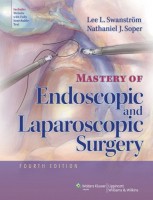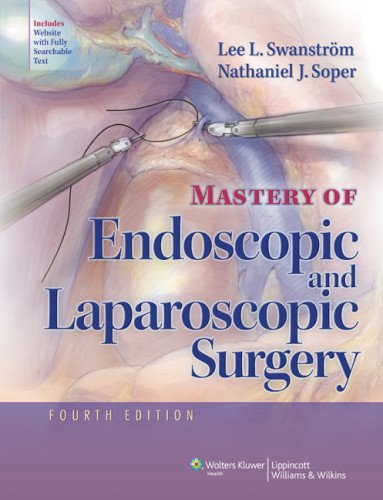 Editors: Lee L. Swanstrom, MD, Nathaniel J. Soper, MD, in conjunction with Michael E. Leonard (Medical Illustrator) and Steven Leeds, MD (Video Link Editor)
Editors: Lee L. Swanstrom, MD, Nathaniel J. Soper, MD, in conjunction with Michael E. Leonard (Medical Illustrator) and Steven Leeds, MD (Video Link Editor)
Publisher: Wolters Kluwer | Lippincott, Williams & Wilkins – 704 pages
Book Review by: Nano Khilnani
Minimally-invasive surgery has become the accepted norm of today, the editors of this book declare in their Preface. This book shows you just how many kinds of procedures are being performed this way these days.
It covers an extensive range of endoscopic and laparoscopic surgeries, with 118 contributors from the United States, and Australia, Canada, France, Germany Japan, and South Korea having written the material found in 60 chapters.
The contents of this book are organized around ten sections, namely:
- Surgical Education: Mastering Minimally Invasive Approaches
- Tools of the Trade
- Minimally Invasive Approaches to the Foregut
- Hepato-Biliary and Pancreatic Surgery
- Minimally Invasive Endocrine Surgery
- Endoscopic Surgery of the Small and Large Bowel
- Abdomen and Abdominal Wall
- Laparoscopic Surgery of the Spleen and Kidney
- Minimally Invasive Thoracic, Pediatric and Gyn Surgery
- New Developments in Endoscopic Surgery
The editors, Drs. Swanstrom and Soper, write that this book, now in its fourth edition, “has achieved the stature of a ‘classic’ in the canon of surgical literature.”
This book comes with access to the complete contents online, full searchable, plus other valuable features. Scratch off the gray sticker on the inside front cover of your book to get your access code. Three simple steps to gain instant access:
1) Visit http://solution.lww.com
2) Enter your access code
3) Follow the instructions to activate your access
The editors point out essentially two themes in this book on laparoscopic and endoscopic surgery, both of which are minimally invasive methods compared to traditional open operations that involve incisions.
- Most of the operations done with a laparoscope “are well matured and backed with many years of outcomes data to support their ‘gold standard’ status…an increasingly important component of any surgical approach in this era of const containment and effectiveness measurements.”
- More and more operations are doable today with a flexible endoscope, so “it is increasingly apparent that the surgeons who relinquish their right to perform endoscopies will face an increasingly narrow spectrum of practice.”
All the sixty chapters in this fifth edition have been updated, and many have been rewritten to give readers the most up-to-date information
Rich, detailed illustrations by the renowned medical artist Michael E. Leonard grace many pages of this book, which look so lifelike, especially those drawn in color and compared with actual photos of organs and surgical instruments.
Let us take a look for example at chapter 30, Endoluminal Treatments for Morbid Obesity.
Aditya Gupta and Kevin M. Reavis, the authors of this chapter write: “Flexible endoscopic approaches may represent the next frontier in the therapeutic intervention of morbid obesity. The indications and patient selection criteria are currently the same as those used in preparation for the three most common minimally invasive surgical treatments used in the United States.”
On page 301 are drawings in color of these three most common minimally invasive surgical treatments used in the United States:
- Gastric bypass
- Sleeve gastrectomy
- Adjustable gastric band.
These drawing shows readers (and surgeons) what is done to reduce intake of food by morbidly obese patients.
Along with illustrations, the other features in the chapters that enhance and improve presentation of material are: an Introduction at the beginning, discussion of the main topics laid out in capital letters; subtopic titles shown in different color letters; Figures that may have either drawings or actual photos; Tables that present information across and down for easy, at-a-glance comparisons; Conclusions; Suggested Readings; and a box labeled as Editor’s Commentary.
All these are plus points that make this book an outstanding one. Along with the numerous physicians, surgeons, scientists and educators whose articles made this book such a valuable one, the three medical editors and the medical illustrator named below are principally responsible for making this textbook an extraordinary one.
Editors:
Lee L. Swanstrom, MD is Chief Innovation Officer (CIO) and Director of Innovations School (I-SIP) at IHU Strasbourg in Strasbourg, France. He also practices Interventional Endoscopy and Foregut Surgery in the Division of Minimally Invasive and Gastrointestinal (GI) Surgery at the Oregon Clinic; and is a Professor of Clinical Surgery at Oregon Health and Science University in Portland, Oregon.
Nathaniel J. Soper, MD is Loyal and Edith Davis Professor and Chair in the Department of Surgery at Northwestern University Feinberg School of Medicine in Chicago, Illinois.
In conjunction with:
Michael E. Leonard, Medical Illustrator in Clement, California
Steven Leeds, MD, Video Link Editor at Portland Province Cancer Center, and The Oregon Clinic in Portland, Oregon.







